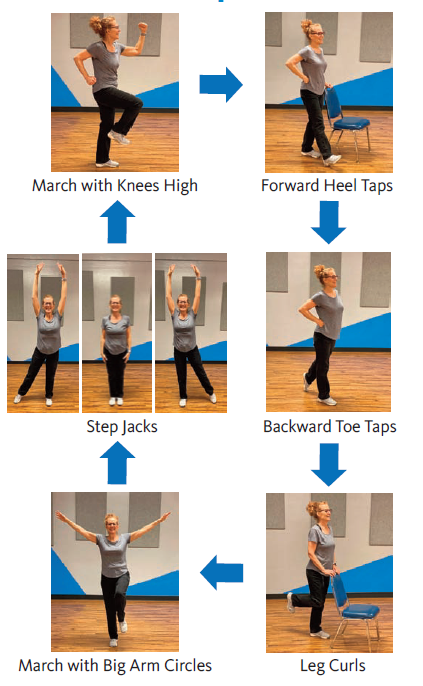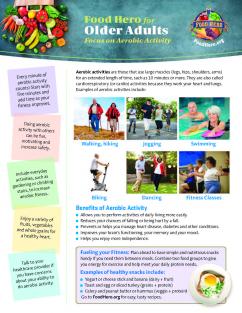Focus on Aerobic Activity
What is aerobic activity?
Aerobic activities are those that use large muscles (legs, hips, shoulders, arms) for an extended length of time, such as 10 minutes or more. They are also called cardiorespiratory (or cardio) activities because they work your heart and lungs.
Examples of aerobic activities include:
- Walking, Hiking
- Jogging
- Swimming
- Biking
- Dancing
- Fitness Classes
Benefits of Aerobic Activity
- Allows you to perform activities of daily living more easily.
- Reduces your chances of falling or being hurt by a fall.
- Prevents or helps you manage heart disease, diabetes and other conditions.
- Improves your brain’s functioning, your memory and your mood.
- Helps you enjoy more independence.
Fueling your Fitness
Plan ahead to have simple and nutritious snacks handy if you need them between meals. Combine two food groups to give you energy for exercise and help meet your daily protein needs.
Examples of healthy snacks include:
- Yogurt or cheese stick and banana (dairy + fruit)
- Toast and egg or sliced turkey (grains + protein)
- Celery and peanut butter or hummus (veggie + protein)
- Find easy, tasty recipes at FoodHero.org
More about Aerobic Activity
- Every minute of aerobic activity counts! Start with five minutes and add time as your fitness improves.
- Doing aerobic activity with others can be fun, motivating and increase safety
- Include everyday activities, such as gardening or climbing stairs, to increase aerobic fitness.
- Enjoy a variety of fruits, vegetables and whole grains for a healthy heart.
- Talk to your healthcare provider if you have concerns about your ability to do aerobic activity
Low-Impact Cardio Routine
Try these 6 exercises to build a cardio routine:
- March with Knees High
- Forward Heel Taps
- Backward Toe Taps
- Leg Curls
- March with Big Arm Circles
- Step Jacks
Tips:
- Have a chair nearby for balance or to rest between exercises if needed.
- If standing is not possible or is uncomfortable, you can do the cardio exercises while seated in a chair.
- Remember to warm up before and cool down after the routine.
- Repeat each exercise for 1 minute before moving on to the next one.
- To enjoy the benefits of aerobic fitness, start with one round of the cardio routine, then work your way up to 5 rounds for a total of 30 minutes.
- Add arm movements, like arm curls or shoulder presses, for an extra challenge that will increase your heart rate and breathing.
Classics Stay Strong
- Stay hydrated while moving your body! Fill a water bottle before exercise.
- Warm up before activity. Walk or march in place for 5 to 10 minutes to gradually increase your heart rate.
- Cool down after activity. Slow your movements to gradually reduce your heart rate and breathing
- If you are new to aerobic activity, start with what you can comfortably do and gradually increase your effort over time.
Rate of Perceived Exertion Scale
Notice how hard you are exercising by using the Rate of Perceived Exertion Scale. Improve your aerobic fitness by exercising between levels 4 and 8.
- Light Intensity (1-3): Can sustain for a long time, can easily carry on a conversation or sing
- Moderate Intensity (4-6): Increased breathing, can hold a short conversation, can't sing
- Vigorous Intensity (7-8): Breathing is faster and deeper, challenging to talk
- Max Effort (9-10): Breathing at a rate you can maintain for only a short time, can't talk
Physical Activity Guidelines for Adults 65+
- Sit less and move more!
- At least 150 minutes a week of moderate intensity activity.
- At least 2 days a week of activities that strengthen muscles.
- Include activities that improve balance, such as standing on one foot.




